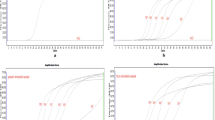Abstract
One resistance mechanism of Haemophilus influenzae to ampicillin involves decreased affinity of penicillin-binding protein (PBP) 3 for β-lactam antibiotics reflecting amino acid substitutions in PBP3 encoded by the ftsI gene. Three amino acid substitutions, Ser385Thr, Arg517His, and Asn526Lys, are especially responsible for β-lactam resistance. We constructed a new real-time polymerase chain reaction (PCR) to directly detect these substitutions in addition to 16S ribosomal RNA (rRNA), cap, and bla TEM genes. Our real-time PCR was evaluated using 206 clinical H. influenzae strains isolated from pediatric patients with meningitis. Relative sensitivities and specificities of real-time PCR were 90.5–100% and 96.3–100% for all resistance classes compared with our previously reported conventional PCR. In addition, real-time PCR shortened time required from 3 h by conventional PCR to 1.5 h. When correlations between combinations of amino acid substitutions in the ftsI gene detected by real-time PCR and minimum inhibitory concentrations (MICs) of β-lactam antibiotics were evaluated, MIC90s of ampicillin for β-lactamase-nonproducing ampicillin-intermediate-resistant strains with Asn526Lys, β-lactamase-nonproducing, ampicillin-resistant strains with Ser385Thr, and β-lactamase-nonproducing ampicillin-resistant strains with both Asn526Lys and Ser385Thr, respectively, were two, four, and eight times higher than those for sensitive strains. Similarly, MIC90s of cephalosporins for these strains, respectively, were two, 16–32, and 16–32 times higher than those for sensitive strains. Thus, real-time PCR can guide antibiotic use.

Similar content being viewed by others
References
García-Cobos S, Campos J, Lázaro E, Román F, Cercenado E, García-Rey C, et al. Ampicillin-resistant non-β-lactamase-producing Haemophilus influenzae in Spain: recent emergence of clonal isolates with increased resistance to cefotaxime and cefixime. Antimicrob Agents Chemother. 2007;51:2564–73.
Pérez-Trallero E, García-de-la-Fuente C, García-Rey C, Baquero F, Aguilar L, Dal-Ré R, et al. Geographical and ecological analysis of resistance, co-resistance, and coupled resistance to antimicrobials in respiratory pathogenic bacteria in Spain. Antimicrob Agents Chemother. 2005;49:1965–72.
Jansen WTM, Verel A, Beitsma M, Verhoef J, Milatovic D. Longitudinal European surveillance study of antibiotic resistance of Haemophilus influenzae. J Antimicrob Chemother. 2006;58:873–7.
Karlowsky JA, Verma G, Zhanel GG, Hoban DJ. Presence of ROB-1 ß-lactamase correlates with cefaclor resistance among recent isolates of Haemophilus influenzae. J Antimicrob Chemother. 2000;45:871–5.
Medeiros AA, Levesque R, Jacoby GA. An animal source for the ROB-1 beta-lactamase of Haemophilus influenzae type b. Antimicrob Agents Chemother. 1986;29:212–5.
Scriver SR, Walmsley SL, Kau CL, Hoban DJ, Brunton J, McGeer A, et al. Determination of antimicrobial susceptibilities of Canadian isolates of Haemophilus influenzae and characterization of their beta-lactamases. Canadian Haemophilus Study Group. Antimicrob Agents Chemother. 1994;38:1678–80.
Vega R, Sadoff HL, Patterson MJ. Mechanisms of ampicillin resistance in Haemophilus influenzae type B. Antimicrob Agents Chemother. 1976;9:164–8.
Ubukata K, Shibasaki Y, Yamamoto K, Chiba N, Hasegawa K, Takeuchi Y, et al. Association of amino acid substitutions in penicillin-binding protein 3 with β-lactam resistance in β-lactamase-negative ampicillin-resistant Haemophilus influenzae. Antimicrob Agents Chemother. 2001;45:1693–9.
Dabernat H, Delmas C, Seguy M, Pelissier R, Faucon G, Bennamani S, et al. Diversity of β-lactam resistance-conferring amino acid substitutions in penicillin-binding protein 3 of Haemophilus influenzae. Antimicrob Agents Chemother. 2002;46:2208–18.
Hasegawa K, Yamamoto K, Chiba N, Kobayashi R, Nagai K, Jacobs MR, et al. Diversity of ampicillin-resistance genes in Haemophilus influenzae in Japan and the United States. Microbial Drug Resist. 2003;9:39–46.
Osaki Y, Sanbongi Y, Ishikawa M, Osaki Y, Kataoka H, Suzuki T, et al. Genetic approach to study the relationship between penicillin-binding protein 3 mutations and Haemophilus influenzae ß-lactam resistance by using site-directed mutagenesis and gene recombinants. Antimicrob Agents Chemother. 2005;49:2834–9.
Straker K, Wootton M, Simm AM, Bennett PM, MacGowan AP, Walsh TR. Cefuroxime resistance in non-ß-lactamase Haemophilus influenzae is linked to mutations in ftsI. J Antimicrob Chemother. 2003;51:523–30.
Ubukata K, Asahi Y, Yamane A, Konno M. Combinational detection of autolysin and penicillin-binding protein 2B genes of Streptococcus pneumoniae by PCR. J Clin Microbiol. 1996;34:592–6.
Nelson MB, Apicella MA, Murphy TF, Vankeulen H, Spotila LD, Rekosh D. Cloning and sequencing of Haemophilus influenzae outer membrane protein P6. Infect Immun. 1988;56:128–34.
Sutcliffe J. G. Nucleotide sequence of the ampicillin resistance gene of Escherichia coli plasmid pBR322. Proc Natl Acad Sci USA. 1978;75:3737–41.
Juteau JM, Levesque RC. Sequence analysis and evolutionary perspectives of ROB-1 beta-lactamase. Antimicrob Agents Chemother. 1990;34:1354–9.
Fleischmann RD, Adams MD, White O, Clayton RA, Kirkness EF, Kerlavage AR, et al. Whole-genome random sequencing and assembly of Haemophilus influenzae Rd. Science. 1995;269:496–512.
Van Eldere J, Brophy L, Loynds B, Celis P, Hancock I, Carman S, et al. Region II of the Haemophilus influenzae type b capsulation locus is involved in serotype-specific polysaccharide synthesis. Mol Microbiol. 1995;15:107–18.
Hasegawa K, Chiba N, Kobayashi R, Murayama SY, Iwata S, Sunakawa K, et al. Rapidly increasing prevalence of β-lactamase-nonproducing, ampicillin-resistant Haemophilus influenzae type b in patients with meningitis. Antimicrob Agents Chemother. 2004;48:1509–14.
Hasegawa K, Kobayashi R, Takada E, Ono A, Chiba N, Morozumi M, et al. High prevalence of type b β-lactamase-non-producing ampicillin-resistant Haemophilus influenzae in meningitis: the situation in Japan where Hib vaccine has not been introduced. J Antimicrob Chemother. 2006;57:1077–82.
Kishii K, Chiba N, Morozumi M, Hamano-Hasegawa K, Kurokawa I, Masaki J, et al. Diverse mutations in the ftsI gene in ampicillin-resistant Haemophilus influenzae isolates from pediatric patients with acute otitis media. J Infect Chemother. 2010;16:87–93.
Chiba N, Murayama SY, Morozumi M, Nakayama E, Okada T, Iwata S, et al. Rapid detection of eight causative pathogens for the diagnosis of bacterial meningitis by real-time PCR. J Infect Chemother. 2009;15:92–8.
Acknowledgments
This study was supported in part by a grant under the category “Research on Emerging and Re-emerging Infectious Diseases” (H21-002), from the Japanese Ministry of Health, Labour and Welfare (to K. Ubukata). We thank Junko Yamamoto of Takara Bio for technical assistance in developing the cycling probe assay.
Author information
Authors and Affiliations
Corresponding author
About this article
Cite this article
Kishii, K., Morozumi, M., Chiba, N. et al. Direct detection by real-time PCR of ftsI gene mutations affecting MICs of β-lactam agents for Haemophilus influenzae isolates from meningitis. J Infect Chemother 17, 671–677 (2011). https://doi.org/10.1007/s10156-011-0256-8
Received:
Accepted:
Published:
Issue Date:
DOI: https://doi.org/10.1007/s10156-011-0256-8




